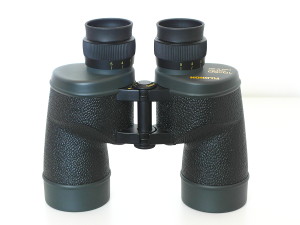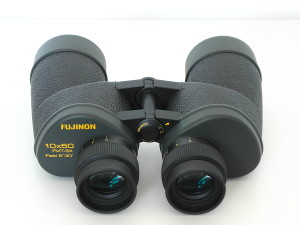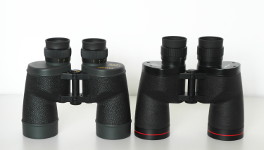

If a binocular is to be used predominantly hand held under the night sky, then 10x50 appears to be a good compromise: The 10x magnification is still manageable without excessive jitter, and 50mm objectives gather quite a significant amount of light. The exit pupil of 5mm is often sufficient under the not so dark night skies in the vicinity of towns, and it also helps to stop down the eye pupils a little bit. The latter effect often improves the perception of star images, because the aberration of our eyes are turning rampant particularly in the peripheral areas of the eye lens.
Since over a decade, the Fujinon FMT-SX series has gained the reputation of being a classic among the high-performance astro binoculars. It is meanwhile available as an improved (FMT-SX2) variant with superior coatings and a slightly shortened body. On the other hand, the Chinese United Optics manufacturer has recently finished a new line of high quality Porro-prism binoculars, which seems to challenge the unique position of Fujinon's FMT(R) series. With a very similar form factor, but an implementation of magnesium alloy for the housing to reduce the instrument's weight, and novel, rather complex eyepiece designs, these binoculars are obviously intended to enter the prime division of astro binoculars. This review is going to show how far they have come.
Fig. 1: The Fujinon 10x50 FMT-SX2
The FMT-SX2 series of Fujinon consists of a 7x50 for marine applications (also available with compass), the 10x50, 10x70 and 16x70 for astronomical observations. The 8x30 FMTR-SX and a similar 6x30 variant are by now unfortunately discontinued. "F" stands for field-flattener, a so called Smyth-lens that is located in front of the image plane. "MT" means marine tested, so that the device is waterproof according to certain military specifications. The "SX" denotes a coating technology, based on a sophisticated electron-beam depletion method that yields a precise control over the thickness of each of the several dielectric layers. More recently, the newly introduced "SX2" indicates a further refinement of the coating. The 10x50 FMT-SX2 is currently available for a market price which fluctuates about 900 Euro. Its predecessor has been reviewed before, here, and here (in German language).
Fig. 2: The United Optics 10x50 Sky Rover. Note the thread for M 55 x 0.75 objective filters (right)
The United Optics Sky Rover is a new line of binoculars which includes 7x50, 10x50, 12x50, 11x70 and 16x70 devices. Internationally, they are also sold under the label "Lunt magnesium binoculars". These binoculars have magnesium alloy bodies, newly designed eyepieces for improved edge-sharpness, state of the art coatings and - still unusual - filter threads which take standard camera filters as well as specially designed nebula filters for visual astronomical observations (as far as I know, these filters are currently not yet available). The 10x50 feels very similar to the Fujinon, solid like a tank and precisely machined. Its design follows along traditional paths, with a classic Vulcanite skin, and prism plates that are fixed by (uncovered) screws. The red ring around the objective has been used before by certain American (i.e. Japanese) brands to indicate optical instruments of particularly high quality. An adapter is available to fix this binocular onto a standard tripod. I don't know anything about the retail price of the Sky Rover, though I have seen the Lunt currently being offered for 349 US$.
 Fig. 3: The Fujinon and the Sky Rover
Fig. 3: The Fujinon and the Sky Rover
The following table summarizes some of the specifications of the two contenders.
| Real angle | Apparent angle | Eye relief | Exit pupil | Close focus | Weight(*) | |
| of view (deg) | of view (deg) | (mm) | diam. (mm) | (m) | (gram) | |
| Fujinon 10x50 FMT-SX2 | 6.5 | 65 | 20 | 5.0 | ~10 | 1370 |
| UO 10x50 Sky Rover | 6.5 | 65 | 20 | 5.0 | ~8 | 1320 |
Image sharpness: Both binoculars offer a perfect sharpness over most parts of their fields of view. The Fujinon has gained some fame for its high degree of field flattening - within about 90% of the angle, measured from the center of field, the star images remain almost perfect points, with only the outermost 10% showing a moderate amount of blur. The Sky Rover reaches that performance closely - stars are perfectly imaged within 80% of the field, again with just a moderate blur close to the edges. This is a respectable result for the Sky Rover, though it is still not sufficient to beat its elder brother in his prime discipline.
Image color: Perfectly neutral without any visible color tint. Impressive is the brightness and the contrast of the images seen through both binoculars. I see no differences here, which indicates that the Sky Rover is obviously equipped with a highly efficient coating.
Rectilinear distortion: Both binoculars display a slight amount of pincushion distortion, implemented in their optical formula to reduce the globe effect of the panning binocular, which would arise when the distortion were fully eliminated. The amount of distortion implemented in both binoculars appears quite similar, and it is well below average, so that the apparent angle of view is actually a little smaller than that computed using the angle condition. As a benefit, straight lines show just a minimum amount of bending when intersecting the outer areas of the field. Some observers who are sensitive to the globe effect may be able to detect that phenomenon, in certain situations in which the binocular is panned.
Stray light: Both binoculars generate a moderate amount of stray light under difficult light conditions. This does happen especially in twilight when the image may suddenly lose contrast as a result of a diffuse stray light entering the optical path, causing a "whiteout". In this discipline, there is definitely room left for improvements. I am unable to locate the origin of that stray light - there are small side pupils just outside the exit pupils, perhaps as a result of a prism leak. During daytime, this stray light is doing no harm, because the observer's eye pupils are too small to touch the side pupils. Under the night sky, the side pupils are usually harmless due to the lack of light, though, during observations near the moon, disturbing reflexes may show up. Quantitatively, both binoculars show a similar susceptibility to such a stray light.
Ghost images: If, at night, a bright object (street lantern, moon) is positioned into the field, reflections on the air-to-glass surfaces take place, which can lead to multiple 'ghost' images of the light source. A successful suppression of these ghosts indicates a high quality of the anti-reflection coating. Not surprisingly, both binoculars are performing perfectly well in this test, and any reflections remain absent. It is always possible, of course, to find an even stronger light source. I have located a stadium light of extreme intensity, and here I could in fact generate ghost images, and they were slightly fainter through the Fujinon, indicating that its coating is still a little more effective than the Sky Rover's. This observation is of zero practical relevance, however, because nobody in his right mind would observe stadium lights, and even the moon is unable to cause any visible ghost images; instead, craters and valleys are imaged under a perfectly high contrast. Here, the Sky Rover actually reaches the high performance level of the Fujinon.
Chromatic aberration (CA): Both binoculars show some color fringing about the edges of objects, whenever these objects are shifted away from the center of field. This is a lateral chromatic aberration, and it is quite visible especially through the Sky Rover. Obviously, none of these binoculars are equipped with low dispersion (ED) glasses. In daylight observations, these color fringes can turn annoying at times, but during astronomical observations they are of little impact. If bright objects like the moon, or bright planets such as Venus or Jupiter are shifted near the edge of field, then the color becomes obvious. As long as these objects remain centered, CA remains absent.
Low light performance: Since both binoculars have the same exit pupils of 5mm, and equally high transmissions, their low light performances are equally high. The Porro prisms are of considerable size, so that the amount of vignetting inside these binoculars is well below the level usually found with their competitors, and those include most of the high end manufacturers. One may call the Fujinon and the Sky Rover heavy, but the investment into well dimensioned prisms is paying off here. The images remain bright and of high contrast over almost the entire field of view, and are capable of displaying faint and diffuse galaxies like M33 or M51 with an astonishing 'punch'. The Andromeda galaxy, M31, shows a distinct bright nucleus and otherwise extends over an impressively wide area.
| Angle of | Image | Stray | Ghost | Color | Low | Image | Mechanical | Final | |
| field | sharpness | light | image | fringing | light | color | construction | score | |
| Fujinon FMT-SX | 1.5 | 2 | 1.5 | 1.5 | 2 | 1.5 | 1.5 | 1 | 12.5 |
| Sky Rover | 1.5 | 1 | 1.5 | 1.5 | 1 | 1.5 | 1.5 | 2 | 11.5 |
The 'final score' is the sum of the individual scores and is intended to serve as an orientation only.
These two binoculars do not only look alike - they are also performing on approximately similar levels. I see the Fujinon somewhat ahead when it comes to the overall optical performance - it thus defends its reputation of being among the best (if not the best of all) hand held astro binoculars in the price sector below 1000 Euro. Yet, the Sky Rover is coming too close to be simply placed into a separate, lower league, and during the overwhelming majority of real life astro observations, this binocular delivers practically the same high level of performance that we are used to find with the Fujinon. Needless to say, this performance is available for less than half of the price of a Fujinon FMTR-SX2. With its reduced weight (though just by a margin) and its filter threads, the Sky Rover is, in certain aspects, offering more than the Fujinon. What I am unable to judge is the efficiency of its quality control, and hence performance variations among different samples of the Sky Rover. During more than a decade of their existence, Fujinon FMT binoculars have gained the reputation of being highly consistent and reliable performers. Now, United Optics has to prove that they are able to offer a similarly high level of quality control, a level that is adequate for a binocular of such a performance (and price tag).
Last modified: May 2016